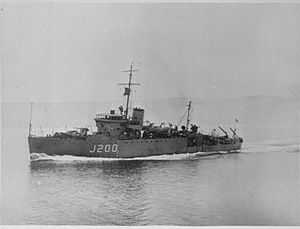HMIS Orissa (J200)
 | |
| Career (India) | |
|---|---|
| Name: | Orissa |
| Ordered: | 24 August 1940 |
| Builder: | Lobnitz & Co. |
| Laid down: | 15 May 1941 |
| Launched: | 20 November 1941 |
| Commissioned: | 14 March 1942 |
| Decommissioned: | 1949 |
| Fate: | Scrapped |
| General characteristics | |
| Class and type: | Bangor-class minesweeper |
| Displacement: | 605 tons |
| Length: | 162 ft (49.4 m) |
| Beam: | 28 ft (8.5 m) |
| Draught: | 8.25 ft (2.51 m) |
| Propulsion: | 2 shafts, 9-cylinder diesel, 2,000 bhp (1,500 kW) |
| Speed: | 16 knots (30 km/h) |
| Complement: | 60 |
| Armament: | 1 × QF 12-pounder 3 in (76.2 mm) gun 1 × quadruple 0.5 in (12.7 mm) Vickers machine gun Mark III |
HMIS Orissa (J200) was a Bangor class minesweeper which served in the Royal Indian Navy (RIN) during World War II.[1]
History
HMIS Orissa was ordered from Lobnitz & Co. originally for the Royal Navy as HMS Clydebank in 1940. However, before she was launched, she was transferred to the Royal Indian Navy and eventually commissioned as Orissa.[2] She served in the RIN during World War II.
Operations in World War II
HMIS Orissa was a part of the Eastern Fleet, and escorted numerous convoys between Africa, British India and Australia in 1943-45.[3][4][5]
On 11 June 1942, Orissa rescued 20 surviving crew of British tanker Geo H. Jones which had been torpedoed and sunk by German submarine U-455, northeast of the Azores in position 45°40′N 22°40′W / 45.667°N 22.667°WCoordinates: 45°40′N 22°40′W / 45.667°N 22.667°W.
On 22 February 1944, Orissa with HMAS Tamworth rescued the surviving crew of the American tanker E.G. Seubert which was torpedoed and sunk by U-510 about 200 nautical miles east of Aden in position 13°50′N 48°49′E / 13.833°N 48.817°E.
Notes
| ||||||||||||||||||